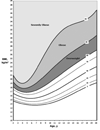Childhood obesity and medical neglect
- PMID: 19117907
- PMCID: PMC3117590
- DOI: 10.1542/peds.2008-0712
Childhood obesity and medical neglect
Abstract
The incidence of childhood obesity has increased dramatically, including severe childhood obesity and obesity-related comorbid conditions. Cases of severe childhood obesity have prompted the following question: does childhood obesity ever constitute medical neglect? In our opinion, removal of a child from the home is justified when all 3 of the following conditions are present: (1) a high likelihood that serious imminent harm will occur; (2) a reasonable likelihood that coercive state intervention will result in effective treatment; and (3) the absence of alternative options for addressing the problem. It is not the mere presence or degree of obesity but rather the presence of comorbid conditions that is critical for the determination of serious imminent harm. All 3 criteria are met in very limited cases, that is, the subset of obese children who have serious comorbid conditions and for whom all alternative options have been exhausted. In these limited cases, a trial of enforced treatment outside the home may be indicated, to protect the child from irreversible harm.
Figures


References
-
- Speiser PW, Rudolf MC, Anhalt H, et al. Childhood obesity. J Clin Endocrinol Metab. 2005;90(3):1871–1887. - PubMed
-
- Freedman DS, Mei Z, Srinivasan SR, Berenson GS, Dietz WH. Cardiovascular risk factors and excess adiposity among overweight children and adolescents: the Bogalusa Heart Study. J Pediatr. 2007;150(1):12–17. - PubMed
-
- Cuttler L, Whittaker JL, Kodish ED. The overweight adolescent: clinical and ethical issues in intensive treatments for pediatric obesity. J Pediatr. 2005;146(4):559–564. - PubMed
-
- Ogden CL, Flegal KM, Carroll MD, Johnson CL. Prevalence and trends in overweight among US children and adolescents, 1999–2000. JAMA. 2002;288(14):1728–1732. - PubMed
Publication types
MeSH terms
Grants and funding
LinkOut - more resources
Full Text Sources
Medical
Miscellaneous

